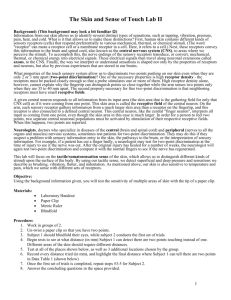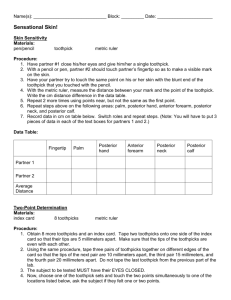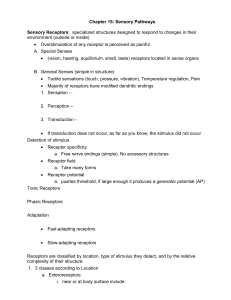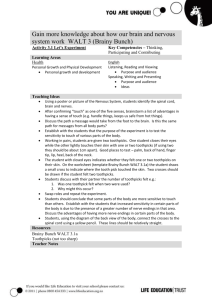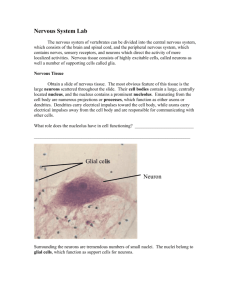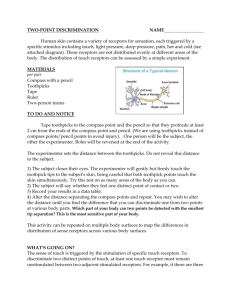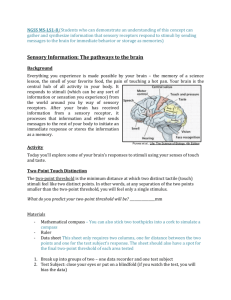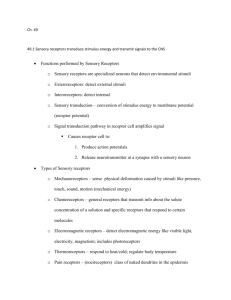LAB 12: How Sensitive is Your Skin
advertisement
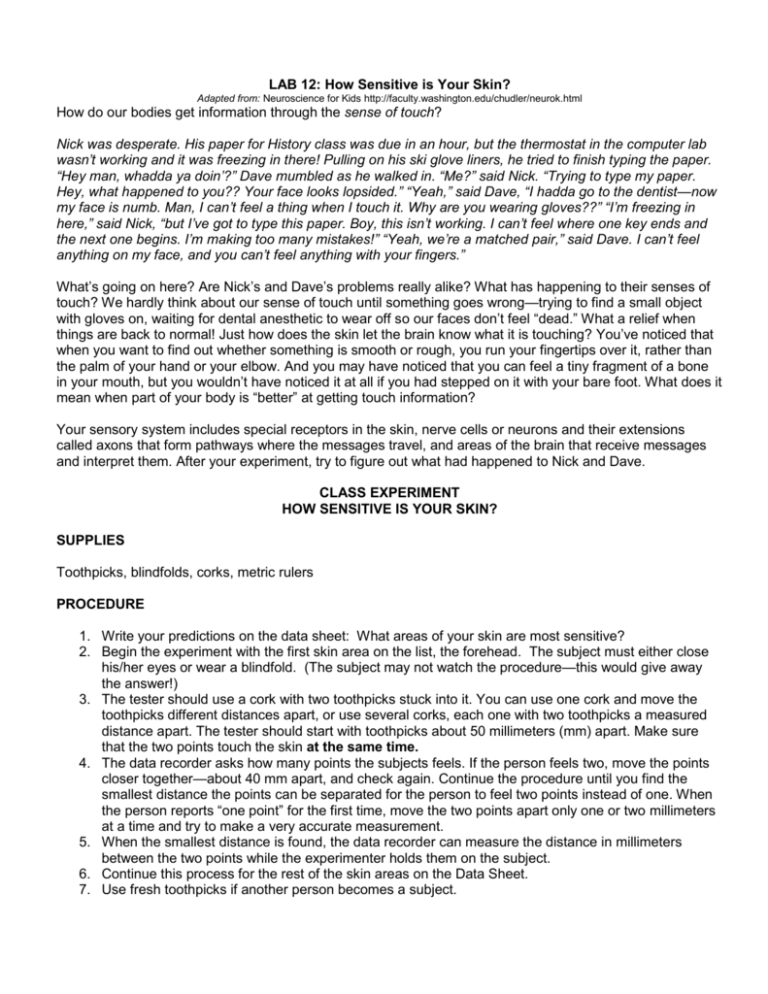
LAB 12: How Sensitive is Your Skin? Adapted from: Neuroscience for Kids http://faculty.washington.edu/chudler/neurok.html How do our bodies get information through the sense of touch? Nick was desperate. His paper for History class was due in an hour, but the thermostat in the computer lab wasn’t working and it was freezing in there! Pulling on his ski glove liners, he tried to finish typing the paper. “Hey man, whadda ya doin’?” Dave mumbled as he walked in. “Me?” said Nick. “Trying to type my paper. Hey, what happened to you?? Your face looks lopsided.” “Yeah,” said Dave, “I hadda go to the dentist—now my face is numb. Man, I can’t feel a thing when I touch it. Why are you wearing gloves??” “I’m freezing in here,” said Nick, “but I’ve got to type this paper. Boy, this isn’t working. I can’t feel where one key ends and the next one begins. I’m making too many mistakes!” “Yeah, we’re a matched pair,” said Dave. I can’t feel anything on my face, and you can’t feel anything with your fingers.” What’s going on here? Are Nick’s and Dave’s problems really alike? What has happening to their senses of touch? We hardly think about our sense of touch until something goes wrong—trying to find a small object with gloves on, waiting for dental anesthetic to wear off so our faces don’t feel “dead.” What a relief when things are back to normal! Just how does the skin let the brain know what it is touching? You’ve noticed that when you want to find out whether something is smooth or rough, you run your fingertips over it, rather than the palm of your hand or your elbow. And you may have noticed that you can feel a tiny fragment of a bone in your mouth, but you wouldn’t have noticed it at all if you had stepped on it with your bare foot. What does it mean when part of your body is “better” at getting touch information? Your sensory system includes special receptors in the skin, nerve cells or neurons and their extensions called axons that form pathways where the messages travel, and areas of the brain that receive messages and interpret them. After your experiment, try to figure out what had happened to Nick and Dave. CLASS EXPERIMENT HOW SENSITIVE IS YOUR SKIN? SUPPLIES Toothpicks, blindfolds, corks, metric rulers PROCEDURE 1. Write your predictions on the data sheet: What areas of your skin are most sensitive? 2. Begin the experiment with the first skin area on the list, the forehead. The subject must either close his/her eyes or wear a blindfold. (The subject may not watch the procedure—this would give away the answer!) 3. The tester should use a cork with two toothpicks stuck into it. You can use one cork and move the toothpicks different distances apart, or use several corks, each one with two toothpicks a measured distance apart. The tester should start with toothpicks about 50 millimeters (mm) apart. Make sure that the two points touch the skin at the same time. 4. The data recorder asks how many points the subjects feels. If the person feels two, move the points closer together—about 40 mm apart, and check again. Continue the procedure until you find the smallest distance the points can be separated for the person to feel two points instead of one. When the person reports “one point” for the first time, move the two points apart only one or two millimeters at a time and try to make a very accurate measurement. 5. When the smallest distance is found, the data recorder can measure the distance in millimeters between the two points while the experimenter holds them on the subject. 6. Continue this process for the rest of the skin areas on the Data Sheet. 7. Use fresh toothpicks if another person becomes a subject. DATA SHEET PREDICTIONS: Skin Area for Testing Data Table Person 1 Person 2 MINIMUM DISTANCE FOR TWO POINT DISCRIMINATION in millimeters (mm) MINIMUM DISTANCE FOR TWO POINT DISCRIMINATION in millimeters (mm) Forehead Cheek Forearm Palm of Hand Tip of Thumb Tip of Index Finger Back of Calf ANALYSIS: THINK ABOUT IT! 1. How do the results compare with each other? 2. Which parts of the body are best at telling that two points are touching them even when the points are very close together? 3. Which skin areas do you think have more receptors, areas that have small two point distances, or large two-point distances? Why do you think so? 4. Which brain area do you think is larger, one receiving information from skin with lots of receptors, or from skin with a few receptors? 5. How does information from sensory receptors in the skin get to the brain? CONCLUSIONS 1. How was the Lab Question answered in your experiment? 2. List three findings you think are important from today’s experiment. Were you surprised by anything you found? 3. How could you improve this experiment? WHAT ELSE CAN WE FIND OUT ABOUT THE SENSE OF TOUCH? Now that you know some ways that touch receptors can be masked, can you think of other ways to interfere with the skin receptors or the nerves that receive or send information? You may not block all messages, but perhaps you can slow them down, or interfere with their interpretation in the brain. For example, you can ask whether the distances you measured for two-point discrimination stay the same under all conditions. Maybe you want to test the touch system in another way. Are the areas that have the best two-point discrimination also best at other sensory jobs? What about judging whether a surface is smooth or rough? Could you use a manual task, such as putting together small nuts and bolts, to see if you can interfere with the sensory information needed for delicate work? We usually use more than one of our senses to accomplish a job. For instance, when putting a puzzle together, we use vision and touch. What happens if you must rely on touch alone? DESIGN AN EXPERIMENT EXPERIMENTAL QUESTION: PROCEDURE (write out the procedure step by step) DATA AND OBSERVATIONS ANALYSIS: 1. What is the control condition for your experiment? 2. What did you change or add for your new experiment? Did you make sure to change only one variable? 3. Did you find a difference between the results from the control experiment and your new experiment? How can you explain the difference? 4. What new information did you get from your experiment, information that you had not heard before? 5. If your new experiment interfered with or masked two-point discrimination, do you think the change in the ability to report two points was a result of interference in the skin (touch receptors and sensory neurons) or in the brain (interpretation of what was felt)? CONCLUSIONS 1. How did your results answer your Lab Question? 2. How certain are you of your conclusions? Would you need more evidence to convince yourself or others that your conclusions are right?
